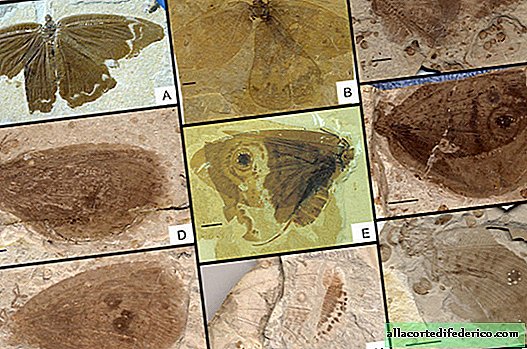Butterfly ancestors learned to "trick" in the Jurassic
Recently, fossils of ancient insects from the family of calligramids were discovered in Brazil. The find is interesting in that it is the largest representative of this family ever found. Its wingspan reached 32 cm. Calligrammatids are very similar in appearance to butterflies, but about 60 million years older than them. They have a similar pattern on the wings and butterfly-like patterns in the form of an eye. And even the pigment melanin, which takes part in the formation of the "eye" pattern, is similar to that of modern butterflies. Moreover, these insects had a proboscis with which they absorbed the nectar of the first angiosperms. According to the researchers, calligramids and butterflies most likely had a common ancestor.
 In the photo: calligrammatide variety
In the photo: calligrammatide varietyInteresting drawings on the wings of calligrammatids that mimic the eyes, according to scientists, should have scared away predators from them. And apparently, there were not a few who wanted to have a snack with them. The wingspan of these primitive butterflies could exceed 30 cm. With such dimensions, it is quite difficult to hide from insectivorous predators, so nature rewarded these creatures with bizarre patterns on the wings. This method of protection in biology is called mimicry, which literally means imitation or disguise. Mimicry is widespread among modern animals, including butterflies. Their main natural enemies can be called insectivorous birds. And in order to survive, nature rewarded these beautiful creatures with witty protection. This is a variety of imitations of the eyes, imitation of the leaves and bark of trees.
 In the photo: mimicry in modern butterflies
In the photo: mimicry in modern butterfliesBut back to the calligramids. It turns out that even then, on the border of the Jurassic and Cretaceous period, they possessed similar evolutionary tricks. It is during this period that gymnosperms with signs of angiosperms appear. And calligrammatids, according to paleobiologists, were just that group of insects that were their first pollinators. Calligrammatid remains were found in great numbers all over the globe, which indicates their mass distribution and prosperous prosperity in the Cretaceous and Jurassic. Why, then, did these contemporaries of the last dinosaurs not survive to this day?
There is no clear answer to this question. Most likely, due to a change in plant ecosystems, adult individuals or their larvae could be left without their usual food. And rapidly changing conditions did not give them time to adapt, like dinosaurs, the last representatives of which disappeared from the face of the earth in the middle of the Cretaceous period. Of the closest relatives of calligramids that have survived to this day, we can name representatives of the order of the retina. They no longer have such impressive sizes and are predatory insects. Perhaps it was the rejection of the plant diet that helped them survive to this day. But what can be asserted with certainty is that the mimicry mechanism has been millions of years old and insects were among the first to master this refined and yet simple protection technology.
 In the photo: lacewing - an insect from the order of the retina.
In the photo: lacewing - an insect from the order of the retina.

















